Global Future: Low-Carbon Economy or High-Carbon Economy?
Abstract
1. Introduction
2. Context and Surrounding the Anthropocene and Decarbonization
3. Methods
3.1. Design of the Literature Review
3.2. Categories and Criteria of the Systematic Review
4. Some Elements to Understand the Anthropocene
4.1. Current
4.2. Prospective
5. Decarbonization
Background and Human Agency in the Scope of Global CO2 Emissions
6. Finding and Discussion
7. Conclusions
Funding
Institutional Review Board Statement
Informed Consent Statement
Data Availability Statement
Conflicts of Interest
References
- Malhi, Y. El concept of the Anthropocene. Annu. Rev. Environ. Resour. 2017, 42, 77–104. [Google Scholar] [CrossRef]
- Steffen, W.; Crutzen, P.; McNeill, J. The anthropocene: Are humans now overwhelming the great forces of nature. Ambio 2007, 36, 614–621. [Google Scholar]
- Castree, N. The anthropocene and the environmental humanities: Extending the conversation. Environ. Humanit. 2014, 5, 233–260. [Google Scholar] [CrossRef]
- Zalasiewicz, J.; Williams, M.; Haywood, A.; Ellis, E. The anthropocene: A new epoch of geological time. Philos. Trans. R. Soc. A 2011, 369, 835–841. [Google Scholar] [CrossRef] [PubMed]
- Erlich, P.; Erlich, A. Can a collapse of global civilization be avoided. Proc. R. Soc. B 2013, 280, 1–9. [Google Scholar] [CrossRef]
- Grumbach, S.; Hamant, O. Digital revolution or anthropocenic feedback? Anthr. Rev. 2018, 5, 87–96. [Google Scholar] [CrossRef]
- Lade, S.; Steffen, W.; de Vries, W.; Carpenter, S.; Donges, J.; Gerten, D.; Hoff, H.; Newbold, T.; Richardson, K.; Rockström, J. Human impacts on planetary boundaries amplified by Earth system interactions. Nat. Sustain. 2020, 3, 119–128. [Google Scholar] [CrossRef]
- Calvo, P. The ethics of Smart City (EoSC): Moral implications of hyperconnectivity, algorithmization and the datafication of urban digital society. Ethics Inf. Technol. 2020, 22, 141–149. [Google Scholar] [CrossRef]
- Anttiroiko, A. Castells network concept and its connections to social, economic and political network analyses. J. Soc. Struct. 2015, 16, 1–18. [Google Scholar] [CrossRef]
- Surugiu, M.-R.; Surugiu, C. International trade, globalization and economic interdependence between european countries: Implications for businesses and marketing framework. Procedia Econ. Financ. 2015, 32, 131–138. [Google Scholar] [CrossRef]
- Popkova, E.; Bogoviz, A.V.; Sergi, B.S. Towards digital society management and ‘capitalism 4.0′ in contemporary Russia. Humanit. Soc. Sci. Commun. 2021, 8, 77. [Google Scholar] [CrossRef]
- Herrfahrdt-Pähle, E.; Schlüter, M.; Olsson, P.; Folke, C.; Gelcich, S.; Pahl-Wostl, C. Sustainability transformations: Socio-political shocks as opportunities for governance transitions. Glob. Environ. Chang. 2020, 63, 102097. [Google Scholar] [CrossRef] [PubMed]
- Görg, C.; Plank, C.; Wiedenhofer, D.; Mayer, A.; Pichler, M.; Schaffartzik, A.; Krausmann, F. Scrutinizing the Great Acceleration: The Anthropocene and its analytic challenges for social-ecological transformations. Anthr. Rev. 2020, 7, 42–61. [Google Scholar] [CrossRef]
- Ceballos, G.; García, A.; Ehrlich, P. The sixth extinction crisis loss of animal populations and species. J. Cosmol. 2010, 8, 1821–1831. [Google Scholar]
- Martin, J.-L.; Maris, V.; Simberloff, D. The need to respect nature and its limits challenges society and conservation science. Proc. Natl. Acad. Sci. USA 2016, 113, 6105–6112. [Google Scholar] [CrossRef]
- Collins, A.; Galli, A.; Hipwood, T.; Murthy, A. Living within a One Planet reality: The contribution of personal Footprint calculator. Environ. Res. Lett. 2020, 15, 1–14. [Google Scholar] [CrossRef]
- IPCC. Summary for Policymakers—Global Warming of 1.5 °C. In Global Warming of 1.5 °C. An IPCC Special Report on the Impacts of Global Warming of 1.5 °C above Pre-Industrial Levels and Related Global Greenhouse Gas Emission Pathways, in the Context of Strengthening the Global Response to the Threat of Climate Change; Masson-Delmotte, V., Zhai, P., Pörtner, H.-O., Roberts, D., Skea, J., Shukla, P.R., Pirani, A., Moufouma-Okia, W., Péan, C., Pidcock, R., et al., Eds.; Sustainable Development, and Efforts to Eradicate Poverty: Geneva, Switzerland, 2018; p. 32. [Google Scholar]
- Hegerl, G.; Luterbacher, J.; Gonzalez-Rouco, F.; Tett, S.F.B.; Crowley, T.; Xoplaki, E. Influence of human and natural forcing on European seasonal temperatures. Nat. Geosci. 2011, 4, 99–103. [Google Scholar]
- Schurer, A.P.; Tett, S.F.B.; Hegerl, G. Small influence of solar variability on climate over the past millennium. Nat. Geosci. 2014, 7, 104–108. [Google Scholar] [CrossRef]
- Abram, N.; McGregor, H.; Tierney, J.; Evans, M.; McKay, N.; Kaufman, D. The PAGES 2k Consortium. Early onset of industrial-era warming across the oceans and continents. Nature 2016, 536, 411–418. [Google Scholar] [CrossRef]
- Koch, A.; Brierley, C.; Maslin, M.M.; Lewis, S.L. Earth system impacts of the European arrival and great dying in the Americas after 1492. Quat. Sci. Rev. 2019, 207, 13–36. [Google Scholar] [CrossRef]
- Hegerl, G.; Brönnimann, S.; Cowan, T.; Friedman, A.; Hawkins, E.; Iles, C.; Muller, W.; Schurer, A.; Undorf, S. Causes of climate change over the historical record. Environ. Res. Lett. 2019, 14, 123006. [Google Scholar] [CrossRef]
- Pavone, I.R. The Paris Agreement and the Trump administration: Road to now here. J. Int. Stud. 2018, 11, 34–49. [Google Scholar] [CrossRef]
- Selby, J. The Trump presidency, climate change, and the prospect of a disorderly energy Transition. Rev. Int. Stud. 2019, 45, 471–490. [Google Scholar] [CrossRef]
- Kedia, S. Approaches to low carbon development in China and India. Adv. Clim. Chang. Res. 2016, 7, 213–221. [Google Scholar] [CrossRef]
- Zhang, Z.X. Making the Transition to a low-carbon economy: The key challenges for China. Asia Pac. Policy Stud. 2016, 3, 187–202. [Google Scholar] [CrossRef]
- Robinson, W. Global capitalism theory and the emergence of transnational elites. Crit. Sociol. 2012, 38, 349–363. [Google Scholar] [CrossRef]
- de la Barra, X. The global social uprising: Limits to predatory capitalism. Crit. Sociol. 2012, 38, 395–399. [Google Scholar] [CrossRef]
- Igwe, I. History of the International Economy: The Bretton Woods System and its Impact on the Economic Development of Developing Countries. Athens J. Law 2018, 4, 105–126. [Google Scholar] [CrossRef]
- Chornyy, O. Influence of the Bretton Woods institutions on economic growth: Literature survey for transitional economic systems. Econ. Sociol. 2011, 4, 32–41. [Google Scholar] [CrossRef] [PubMed]
- Umeonyirioha, E. The Bretton Woods International Financial Institutions: Perspective of the Underdeveloped States. World J. Soc. Sci. Humanit. 2020, 6, 15–21. [Google Scholar] [CrossRef]
- Jackson, R.B.; Friedlingstein, P.; Andrew, R.M.; Canadell, J.G.; Le Quéré, C.; Peters, G.P. Persistent fossil fuel growth threatens the Paris Agreement and planetary health. Environ. Res. Lett. 2019, 14, 1–8. [Google Scholar] [CrossRef]
- Tollefson, J. Can Joe Biden make good on his ambitious climate agenda? Nature 2020, 588, 206–207. [Google Scholar] [CrossRef]
- Lui, S.; Kuramochi, T.; Smit, S.; Roelfsema, M.; Hsu, A.; Weinfurter, A.; Chan, S.; Hale, T.; Fekete, H.; Lütkehermöller, K.; et al. Correcting course: The emission reduction potential of international cooperative initiatives. Clim. Policy 2021, 21, 232–250. [Google Scholar] [CrossRef]
- Binsted, M.; Iyer, G.; Edmonds, J.; Vogt-Schilb, A.; Arguello, R.; Cadena, A.; Delgado, R.; Feijoo, F.; Lucena, A.F.P.; McJeon, H.; et al. Stranded asset implications of the Paris Agreement in Latin America and the Caribbean. Environ. Res. Lett. 2020, 15, 044026. [Google Scholar] [CrossRef]
- Harris, N.L.; Gibbs, D.A.; Baccini, A.; Birdsey, R.A.; De Bruin, S.; Farina, M.; Fatoyinbo, L.; Hansen, M.C.; Herold, M.; Houghton, R.A.; et al. Global maps of twenty-first century forest carbon fluxes. Nat. Clim. Chang. 2021, 11, 234–240. [Google Scholar] [CrossRef]
- Chuvieco, E.; Pettinari, M.L.; Koutsias, N.; Forkel, M.; Hantson, S.; Turco, M. Human and climate drivers of global biomass burning variability. Sci. Total Environ. 2021, 779, 146361. [Google Scholar] [CrossRef]
- Brugger, H.; Eichhammer, W.; Mikova, N.; Donitz, E. Energy efficiency vision 2050: How will new societal trends influence energy future energy demand in the European countries. Energy Policy 2021, 152, 112216. [Google Scholar] [CrossRef]
- Sovacool, B.K.; Demski, C.; Noel, L. Beyond climate, culture and confort in European preferences for low-carbon heat. Glob. Environ. Chang. 2021, 66, 102200. [Google Scholar] [CrossRef]
- Pantucci, R. The many faces of China’s belt and road initiative. Curr. Hist. 2021, 120, 28–34. [Google Scholar] [CrossRef]
- Brakman, S.; Frankopan, P.; Garretsen, H.; Van Marrewijk, C. The New Silk Roads: An introduction to China’s Belt and Road Initiative. Camb. J. Reg. Econ. Soc. 2019, 12, 3–16. [Google Scholar] [CrossRef]
- Pieper, M. The linchpin of Eurasia: Kazakhstan and the Eurasian economic union between Russia’s defensive regionalism and China’s new Silk Roads. Int. Politics 2020. [Google Scholar] [CrossRef]
- OECD. The Belt and Road Initiative in the Global Trade, Investment and Finance Landscape, in OECD Business and Finance Outlook 2018; OECD Publishing: Paris, France, 2018. [Google Scholar] [CrossRef]
- Arora, S.; Bhaukhandi, K.D.; Mishra, P.K. Coronavirus lockdown helped the environment to bounce back. Sci. Total Environ. 2020, 742, 140573. [Google Scholar] [CrossRef] [PubMed]
- Ali, S.M. China’s Belt and Road: An Evolving Network. China’s Belt Road Vis. Geoecon. Geopolit. 2020, 69–121. [Google Scholar] [CrossRef]
- Blanchard, J.-M. Problematic Prognostications about China’s Maritime Silk Road Initiative (MSRI): Lessons from Africa and the Middle East. J. Contemp. China 2020, 29, 159–174. [Google Scholar] [CrossRef]
- Zhang, Y.; Zheng, X.; Cai, W.; Liu, Y.; Luo, H.; Guo, K.; Bu, C.; Li, J.; Wang, C. Key drivers of the rebound trend of China’s CO2 emissions. Environ. Res. Lett. 2020, 15, 104049. [Google Scholar] [CrossRef]
- Union of Concerned Scientists. Global Warming Fact: More Than Half of All Industrial CO2 Pollution Has Been Emitted Since 1988. 2020. Available online: https://blog.ucsusa.org/peter-frumhoff/global-warming-fact-co2-emissions-since-1988-764 (accessed on 2 July 2020).
- Peters, G.P.; Andrew, R.M.; Canadell, J.G.; Friedlingstein, P.; Jackson, R.B.; Korsbakken, J.I.; Le Quéré, C.; Peregon, A. Carbon dioxide emissions continue to grow amidst slowly emerging climate policies. Nat. Clim. Chang. 2020, 10, 3–6. [Google Scholar] [CrossRef]
- Fieldman, G. Finance Unchained: The Political Economy of Unsustainability. Sustainability 2020, 12, 2545. [Google Scholar] [CrossRef]
- Daggash, H.; Heuberger, C.; MacDowell, N. The role and value of negative emissions technologies in decarbonising the UK energy system. Int. J. Greenh. Gas Control 2019, 81, 181–198. [Google Scholar] [CrossRef]
- Viola, L.A. US strategies of institutional adaptation in the face of hegemonic decline. Glob. Policy 2020, 11 (Suppl. S3), 28–39. [Google Scholar] [CrossRef]
- Dubash, N.K.; Khosla, R.; Rao, N.D.; Bhardwaj, A. India’s energy and emissions future: An interpretive analysis of model scenarios. Environ. Res. Lett. 2018, 13, 074018. [Google Scholar] [CrossRef]
- Moore, A. Anthropocene anthropology: Reconceptualizing contemporary global change. J. R. Anthropol. Inst. 2016, 22, 27–46. [Google Scholar] [CrossRef]
- Crutzen, P. The Anthropocene. In Earth System Science in the Anthropocene; Ehlers, E., Krafft, T., Eds.; Springer: Berlin/Heidelberg, Germany, 2006. [Google Scholar]
- Velders, G.; Andersen, S.; Daniel, J.; Fahey, D.; McFarland, M. The importance of the Montreal Protocol in protecting climate. Proc. Natl. Acad. Sci. USA 2007, 104, 4814–4819. [Google Scholar] [CrossRef] [PubMed]
- Otto, I.; Wiedermann, M.; Cremades, R.; Donges, J.; Auer, C.; Lucht, W. Human agency in the Anthropocene. Ecol. Econ. 2020, 167, 106463. [Google Scholar] [CrossRef]
- Long, N. Sociología del Desarrollo: Una Perspectiva Centrada en el Actor; COLSAN-CIESAS: San Luis Potosi, México, 2007. [Google Scholar]
- Ceballos, G.; Ehrlich, P.; Dirzo, R. Population losses and the sixth mass extinction. Proc. Natl. Acad. Sci. USA 2017, 114, E6089–E6096. [Google Scholar] [CrossRef] [PubMed]
- Wackernagel, M.; Williams, R. Our Ecological Footprint; New Society Publishers: Filadelfia, Paraguay, 1996. [Google Scholar]
- Brand, U.; Görg, C.; Wissen, M. Overcoming neoliberal globalization: Social-ecological transformation from a Polanyian perspective and beyond. Globalizations 2020, 17, 161–176. [Google Scholar] [CrossRef]
- NOAA. Earth System Research Laboratory: Trends in Atmospheric Carbon Dioxide. 2021. Available online: https://www.esrl.noaa.gov/gmd/ccgg/trends/gl_trend.html (accessed on 1 March 2021).
- Lenzen, M.; Li, M.; Malik, A.; Pomponi, F.; Sun, Y.Y.; Wiedmann, T.; Faturay, F.; Fry, J.; Gallego, B.; Geschke, A.; et al. Global socio-economic losses and environmental gains from the coronavirus pandemic. PLoS ONE 2020, 15, e0235654. [Google Scholar] [CrossRef]
- WHO. Coronavirus (COVID-19) Dashboard. 2021. Available online: https://covid19.who.int (accessed on 7 April 2021).
- Lander, E.S.; Linton, L.M.; Birren, B.; Nusbaum, C.; Zody, M.C.; Baldwin, J.; Devon, K.; Dewar, K.; Doyle, M.; FitzHugh, W.; et al. Initial sequencing and analysis of the human genome. Nature 2001, 409, 860–921. [Google Scholar]
- Comte, A. A General View of Positivism; Bridges, J.H., Translator; Routledge: London, UK, 1908. [Google Scholar]
- Barouki, R.; Kogevinas, M.; Audouze, K.; Belesova, K.; Bergman, A.; Birnbaum, L.; Boekhold, S.; Denys, S.; Desseille, C.; Drakvik, E.; et al. The COVID-19 pandemic and global environmental change: Emerging research needs. Environ. Int. 2021, 146, 106272. [Google Scholar] [CrossRef]
- Toledo, V. El metabolismo social: Una nueva teoría socioecológica. Relaciones 2013, 136, 41–71. [Google Scholar]
- Fischer-Kowalski, M.; Krausmann, F.; Pallua, I. A sociometabolic reading of the Anthropocene: Modes of subsistence, population size and human impact on Earth. Anthr. Rev. 2014, 1, 8–33. [Google Scholar] [CrossRef]
- Lenton, T.M.; Pichler, P.-P.; Weisz, H. Revolutions in energy input and material cycling Earth history and human history. Earth Syst. Dyn. 2016, 7, 353–370. [Google Scholar] [CrossRef]
- Schaffer, L.M.; Spilker, G. Self-interest versus sociotropic considerations: An information-based perspective to understanding individuals’ trade preferences. Rev. Int. Political Econ. 2019, 26, 1266–1292. [Google Scholar] [CrossRef]
- Frantz, C.; Mayer, S.; Norton, C.; Rock, M. There is no “I” in nature: The influence of self-awareness on connectedness to nature. J. Environ. Psychol. 2005, 25, 427–436. [Google Scholar] [CrossRef]
- Gifford, R. The dragons of inaction: Psychological barriers that limit climate change mitigation and adaptation. Am. Psychol. 2011, 66, 290–302. [Google Scholar] [CrossRef]
- Komatsu, H.; Rappleye, J.; Silova, I. Culture and the independent self: Obstacles to environmental sustainability. Anthropocene 2019, 26, 100198. [Google Scholar] [CrossRef]
- Paramio, L. Teorías de la decisión racional y de la acción colectiva. Sociológica 2005, 57, 13–34. [Google Scholar]
- Miller, L.M. Acción colectiva y modelos de racionalidad. Estud. Front. 2004, 5, 107–130. [Google Scholar]
- Lugo-Morin, D.R. La multi-racionalidad económica del pequeño productor en los territorios rurales. Span. J. Rural Dev. 2011, 2, 21–38. [Google Scholar] [CrossRef]
- WMO. Global Atmosphere Watch Programme (GAW). 2020. Available online: https://community.wmo.int/activity-areas/gaw (accessed on 10 December 2020).
- U.S. Energy Information Administration. Emisiones Totales de CO2 a Nivel Global 1980–2017. 2020. Available online: https://www.eia.gov/international/data/world/other-statistics (accessed on 10 December 2020).
- GEO5. Perspectivas del Medio Ambiente Mundial; Programa de las Naciones Unidas para el Medio Ambiente: Nairobi, Kenya, 2012. [Google Scholar]
- Zalasiewicz, J.; Waters, C.N.; Summerhayes, C.P.; Wolfe, A.P.; Barnosky, A.D.; Cearreta, A.; Crutzen, P.; Ellis, E.; Fairchild, I.J.; Gałuszka, A.; et al. The Working Group on the Anthropocene: Summary of evidence and interim recommendations. Anthropocene 2017, 19, 55–60. [Google Scholar] [CrossRef]
- Lewis, S.; Maslin, M. Defining the Anthropocene. Nature 2015, 519, 171–180. [Google Scholar] [CrossRef]
- Gillings, M.; Paulsen, I. Microbiology of the Anthropocene. Anthropocene 2014, 5, 1–8. [Google Scholar] [CrossRef]
- Brondizio, E.; O’Brien, K.; Bai, X.; Biermann, F.; Steffen, W.; Berkhout, F.; Cudennec, C.; Lemos, M.; Wolfe, A.; Palma-Oliveira, J.; et al. Re-conceptualizing the Anthropocene: A call for collaboration. Glob. Environ. Chang. 2016, 39, 318–327. [Google Scholar] [CrossRef]
- Hmiel, B.; Petrenko, V.V.; Dyonisius, M.N.; Buizert, C.; Smith, A.M.; Place, P.F.; Harth, C.; Beaudette, R.; Hua, Q.; Yang, B.; et al. Preindustrial 14CH4 indicates greater anthropogenic fossil CH4 emissions. Nature 2020, 578, 409–412. [Google Scholar] [CrossRef]
- Turetsky, M.; Abbott, B.; Jones, M.; Anthony, K.; Olefeldt, D.; Schuur, E.; Koven, C.; McGuire, D.; Grosse, G.; Kuhry, P.; et al. Permafrost collapse is accelerating carbon release. Nature 2019, 569, 32–34. [Google Scholar] [CrossRef] [PubMed]
- Yuewen, D.; Adzigbli, L. Assessing the impact of oil spills on marine organisms. J. Oceanogr. Mar. Res. 2017, 6, 1–7. [Google Scholar] [CrossRef]
- Qing, Q.L.; Loganath, A.; Chong, Y.; Tan, J.; Philip, J. Persistent Organic Pollutants and Adverse Health Effects in Humans. J. Toxicol. Environ. Health 2006, 69, 1987–2000. [Google Scholar] [CrossRef]
- Konikow, L.; Kendy, E. Groundwater depletion: A global problem. Hydrogeol. J. 2005, 13, 317–320. [Google Scholar] [CrossRef]
- Kassas, M. The biosphere and the threat of global industrialisation: Limits of the biosphere. Environmentalist 1989, 9, 261–268. [Google Scholar] [CrossRef]
- Cowgill, U. Acid precipitation: A review. Stud. Environ. Sci. 1984, 35, 233–259. [Google Scholar]
- Duguma, L.; Atela, J.; Minang, P.; Ayana, A.; Gizachew, B.; Nzyoka, J.; Bernard, F. Deforestation and Forest Degradation as an Environmental Behavior: Unpacking Realities Shaping Community Actions. Land 2019, 8, 26. [Google Scholar] [CrossRef]
- Carvalho, F. Pesticides, environment and food safety. Food Energy Secur. 2017, 6, 48–60. [Google Scholar] [CrossRef]
- Baisero, D.; Visconti, P.; Pacifici, M.; Cimatti, M.; Rondinini, C. Projected Global Loss of Mammal Habitat Due to Land-Use and Climate Change. One Earth 2020, 2, 578–585. [Google Scholar] [CrossRef]
- Reyes-Garcia, V.; Gueze, M.; Luz, A.; Paneque-Gálvez, J.; Macía, M.; Orta-Martinez, M.; Pino, J.; Rubio-Campillo, X. Evidence of Traditional Knowledge Loss among a Contemporary Indigenous Society. Evol. Hum. Behav. 2013, 34, 249–257. [Google Scholar] [CrossRef]
- Hrubec, M.; Uhde, Z. Global Conflicts and Local Interactions: Contradictions of Global Capitalism and Civil Society. Crit. Sociol. 2018, 45, 1–7. [Google Scholar] [CrossRef]
- Martins, F.; Felgueiras, C.; Smitkova, M.; Caetano, N. Analysis of Fossil Fuel Energy Consumption and Environmental Impacts in European Countries. Energies 2019, 12, 964. [Google Scholar] [CrossRef]
- Lambin, E.; Geist, H.; Lepers, E. Dynamics of Land-use and land-cover change in tropical regions. Annu. Rev. Environ. Resour. 2002, 20, 205–241. [Google Scholar]
- Babic, M. Let’s talk about the interregnum: Gramsci and the crisis of the liberal world order. Int. Aff. 2020, 96, 767–786. [Google Scholar] [CrossRef]
- Bai, X.; van der Leeuw, S.; O’Brien, K.; Berkhout, F.; Biermann, F.; Brondizio, E.; Cudennec, C.; Dearing, J.; Duraiappah, A.; Glaser, M.; et al. Plausible and desirable futures in the Anthropocene: A new research agenda. Glob. Environ. Chang. 2016, 39, 351–362. [Google Scholar] [CrossRef]
- Bonneuil, C. The geological turn: Narratives of the Anthropocene. In The Anthropocene and the Global Environmental Crisis: Rethinking Modernity in a New Epoch; Hamilton, C., Bonneuil, C., Gemenne, C.F., Eds.; Routledge: London, UK, 2015; pp. 15–31. [Google Scholar]
- Danowski, D.; Viveiros de Castro, E. Los miedos y los fines… del mundo. Rev. Nueva Soc. 2019, 283, 37–46. [Google Scholar]
- Latour, B. Telling friends from foes in the time of the Anthropocene. In The Anthropocene and the Global Environmental Crisis: Rethinking Modernity in a New Epoch; Hamilton, C., Bonneuil, C., Gemenne, C.F., Eds.; Routledge: London, UK, 2015; pp. 145–155. [Google Scholar]
- Descola, P. Beyond Culture and Nature. J. Ethnogr. Theory 2012, 2, 447–471. [Google Scholar] [CrossRef]
- Hornborg, A.; McNeill, J.; Martinez-Alier, J. Rethinking Environmental History: World-System History and Global Environmental Change; Altamira Press: Lanham, MD, USA, 2007. [Google Scholar]
- Tainter, J. Archaeology of overshoot and collapse. Annu. Rev. Anthropol. 2006, 35, 59–74. [Google Scholar] [CrossRef]
- Diamond, J. Collapse: How Societies Choose to Fail or Succeed; Viking Penguin: New York, NY, USA, 2005. [Google Scholar]
- Meadows, D.; Meadows, D.; Randers, J.; Behrens, W. The Limits to Growth; Universe Books: New York, NY, USA, 1972. [Google Scholar]
- Marx, K.; El Capital, T. Libro Primero, El Proceso de Producción del Capital; Siglo XXI: México City, México, 1975; Volume 2. [Google Scholar]
- Brzezinski, M. Income Polarization and Economic Growth; National Bank of Poland Working Paper No. 147; SSRN: Rochester, NY, USA, 2013. [Google Scholar] [CrossRef]
- Roope, L.; Niño-Zarazúa, M.; Tarp, F. How polarized is the global income distribution? Econ. Lett. 2018, 167, 86–89. [Google Scholar] [CrossRef]
- Habets, I. Democracia liberal: La amenaza de las contranarrativas. Eur. View 2015, 14, 145–154. [Google Scholar] [CrossRef]
- Becker, J.; Raza, W. Theory of regulation and political ecology an inevitable separation. Ambiente Soc. 1999, 5, 5–17. [Google Scholar] [CrossRef]
- van der Leeuw, S.; Folke, C. The social dynamics of basins of attraction. Ecol. Soc. 2021, 26, 33. [Google Scholar] [CrossRef]
- IPCC. The Physical Science Basis. In Contribution of Working Group I to the Fourth Assessment Report of the Intergovernmental Panel on Climate Change; Cambridge University Press: Cambridge, UK, 2007. [Google Scholar]
- Keller, D.; Lenton, A.; Littleton, E.; Oschlies, A.; Scott, V.; Vaughan, N. The Effects of Carbon Dioxide Removal on the Carbon Cycle. Curr. Clim. Chang. Rep. 2018, 4, 250–265. [Google Scholar] [CrossRef]
- Tol, R. The structure of the climate debate. Energy Policy 2017, 104, 431–438. [Google Scholar] [CrossRef]
- Duijndam, S.; van Beukering, P. Understanding public concern about climate change in Europe, 2008–2017: The influence of economic factors and right-wing populism. Clim. Policy 2021, 21, 353–367. [Google Scholar] [CrossRef]
- van Beek, L.; Hajer, M.; Pelzer, P.; van Vuuren, D.; Cassen, C. Anticipating futures through models: The rise of integrated assessment modelling in the climate science-policy interface since 1970. Glob. Environ. Chang. 2020, 65, 102191. [Google Scholar] [CrossRef]
- Zakkour, P.D.; Heidug, W.; Howard, A.; Haszeldine, R.S.; Allen, M.R.; Hone, D. Progressive supply-side policy under the Paris Agreement to enhance geological carbon storage. Clim. Policy 2021, 21, 63–77. [Google Scholar] [CrossRef]
- Tortell, P. Earth 2020: Science, society, and sustainability in the Anthropocene. Proc. Natl. Acad. Sci. USA 2020, 117, 8683–8691. [Google Scholar] [CrossRef] [PubMed]
- Molina, M.; Rowland, S. Stratospheric sink for chlorofluoromethanes: Chlorine atom-catalysed destruction of ozone. Nature 1974, 249, 810–812. [Google Scholar] [CrossRef]
- Kannan, K.; Tanabe, S.; Giesy, J.; Tatsukawa, R. Organochlorine pesticides and polychlorinated biphenyls in foodstuffs from Asian and oceanic countries. Rev. Environ. Contam. Toxicol. 1997, 152, 1–55. [Google Scholar] [PubMed]
- Steinbacher, M.; Vollmer, M.K.; Buchmann, B.; Reimann, S. An evaluation of the current radiative forcing benefit of the Montreal Protocol at the high-Alpine site Jungfraujoch. Sci. Total Environ. 2008, 391, 217–223. [Google Scholar] [CrossRef]
- Kanter, D.; Mauzerall, D.; Ravishankara, A.R.; Daniel, J.; Portmann, R.; Grabiel, P.; Moomaw, W.; Galloway, J. A post-Kyoto partner: Considering the stratospheric ozone regime as a tool to manage nitrous oxide. Proc. Natl. Acad. Sci. USA 2013, 110, 4451–4457. [Google Scholar] [CrossRef]
- Ghani, G. The Montreal Protocol: Developing Countries Import of Halons. Econ. Bull. 2007, 17, 1–5. [Google Scholar]
- Ivanova, K. Corruption, illegal trade and compliance with the Montreal Protocol. Environ. Resour. Econ. 2007, 38, 475–496. [Google Scholar] [CrossRef]
- Stone, C. Common but Differentiated Responsibilities in International Law. Am. J. Int. Law 2004, 98, 276–301. [Google Scholar] [CrossRef]
- Jotzo, F. Developing countries and the future of the kyoto protocol. Glob. Chang. Peace Secur. 2005, 17, 77–86. [Google Scholar] [CrossRef][Green Version]
- Keenan, T.; Prentice, C.; Canadell, J.; Williams, C.; Wang, H.; Raupach, M.; Collatz, J. Recent pause in the growth rate of atmospheric CO2 due to enhanced terrestrial carbon uptake. Nat. Commun. 2017, 8, 1–10. [Google Scholar] [CrossRef]
- Zahnle, K.; Schaefer, L.; Fegley, B. Earth’s Earliest Atmospheres. Cold Spring Harb. Perspect. Biol. 2010, 2, a004895. [Google Scholar] [CrossRef]
- Hart, M. The evolution of the atmosphere of the Earth. Icarus 1978, 33, 23–39. [Google Scholar] [CrossRef]
- Oschmann, W.; Grasshoff, M.; Gudo, M. The early evolution of the planet earth and the origin of life. Senckenbergiana Lethaea 2002, 82, 284–294. [Google Scholar] [CrossRef]
- Pearce, B.; Tupper, A.; Pudritz, R.; Higgs, P. Constraining the Time Interval for the Origin of Life on Earth. Astrobiology 2018, 18, 343–364. [Google Scholar] [CrossRef] [PubMed]
- Shaw, G. Earth’s atmosphere–Hadean to early Proterozoic. Chem. Der Erde-Geochem. 2008, 68, 235–264. [Google Scholar] [CrossRef]
- Abe, Y.; Matsui, T. Early Evolution of the Earth: Accretion, Atmosphere Formation, and Thermal History. J. Geophys. Res. 1986, 91, E291–E302. [Google Scholar] [CrossRef]
- Zahnle, K.; Kasting, J.; Pollack, J. Evolution of a steam atmosphere during Earth’s accretion. Icarus 1988, 74, 62–97. [Google Scholar] [CrossRef]
- Genda, H. Origin of Earth’s oceans: An assessment of the total amount, history and supply of water. Geochem. J. 2016, 50, 27–42. [Google Scholar] [CrossRef]
- Sorokhtin, O.; Ghilingar, G.; Khlyuk, L.; Gorfunkel, M. Evolution of the Earth’s Global Climate. Energy Sources Part A 2007, 29, 1–19. [Google Scholar] [CrossRef]
- Sofia, D.; Gioiella, F.; Lotrecchiano, N.; Giuliano, A. Cost-benefit analysis to support decarbonization scenario for 2030: A case study in Italy. Energy Policy 2020, 137, 111137. [Google Scholar] [CrossRef]
- Leiss, W. A global decarbonisation bond. Environ. Res. Lett. 2019, 14, 091003. [Google Scholar] [CrossRef]
- Pye, S.; Broad, O.; Bataille, C.; Brockway, P.; Daly, H.; Freeman, R.; Gambhir, A.; Geden, O.; Rogan, F.; Sanghvi, S.; et al. Modelling net-zero emissions energy systems requires a change in approach. Clim. Policy 2021, 21, 222–231. [Google Scholar] [CrossRef]
- Rueda, O.; Mogollón, J.M.; Tukker, A.; Scherer, L. Negative-emissions technology portfolios to meet the 1.5 °C target. Glob. Environ. Chang. 2021, 67, 102238. [Google Scholar] [CrossRef]
- Millward-Hopkins, J.; Steinberger, J.; Rao, N.D.; Oswald, Y. Providing decent living with minimum energy: A global scenario. Glob. Environ. Chang. 2020, 65, 102168. [Google Scholar] [CrossRef]
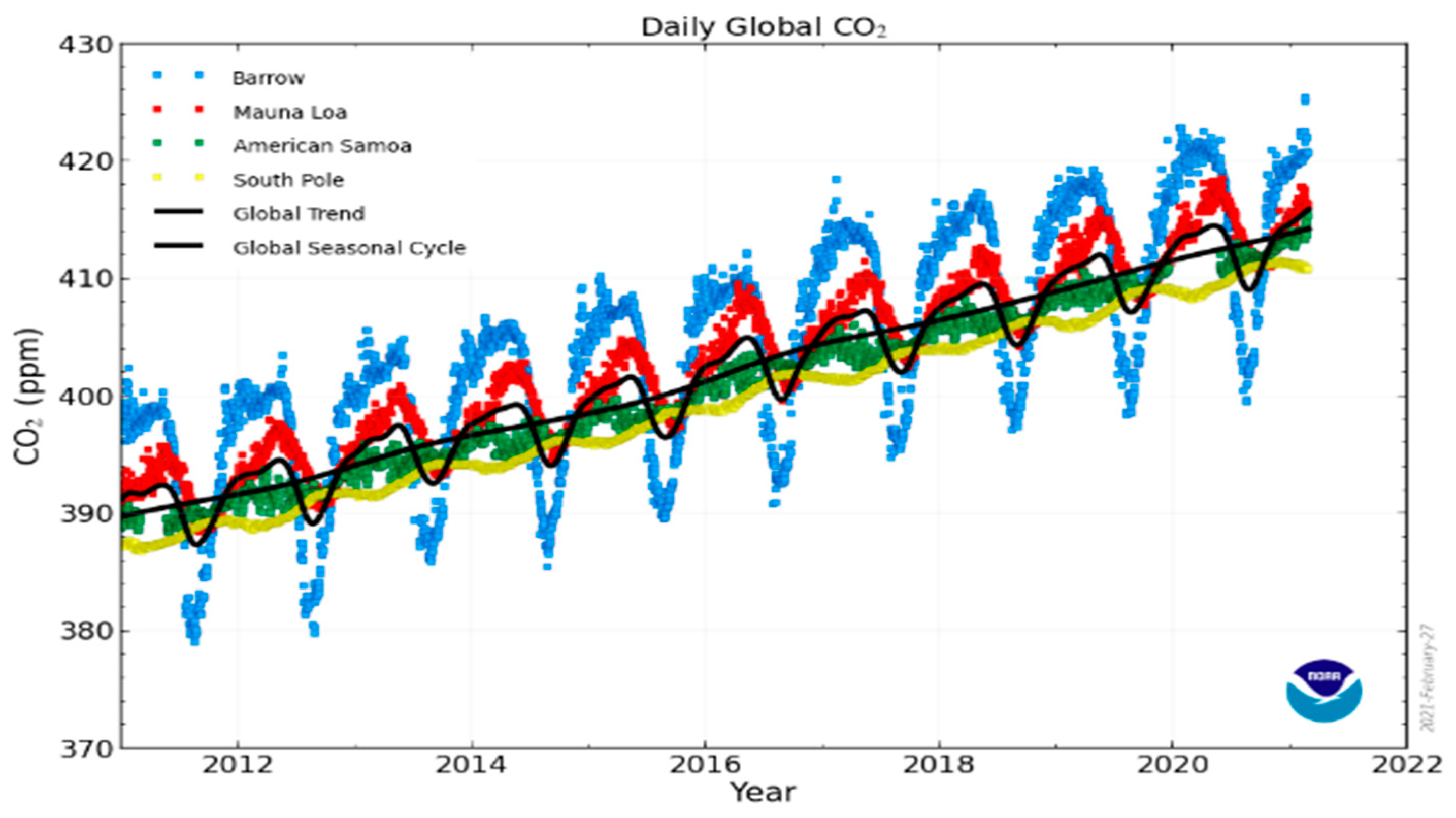
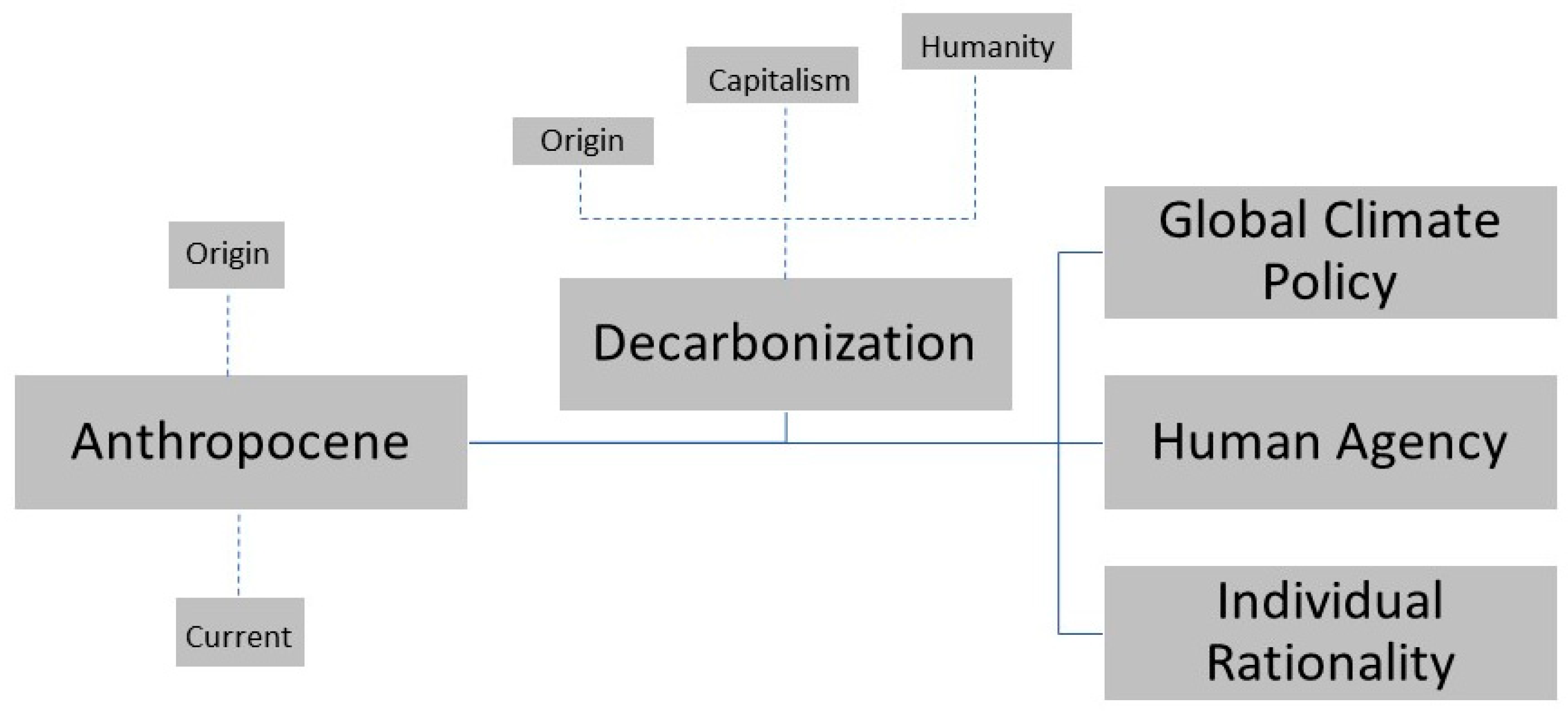
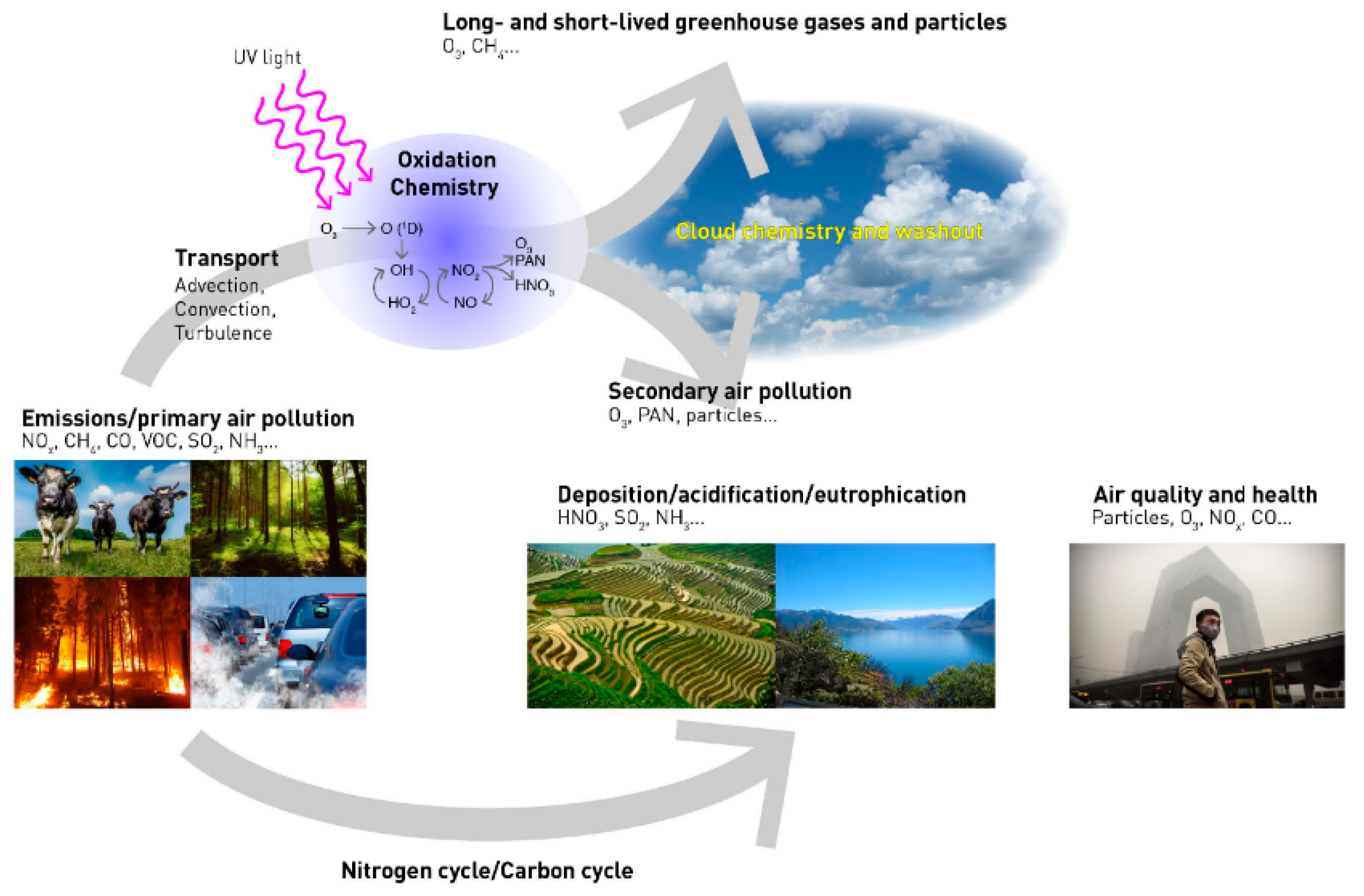
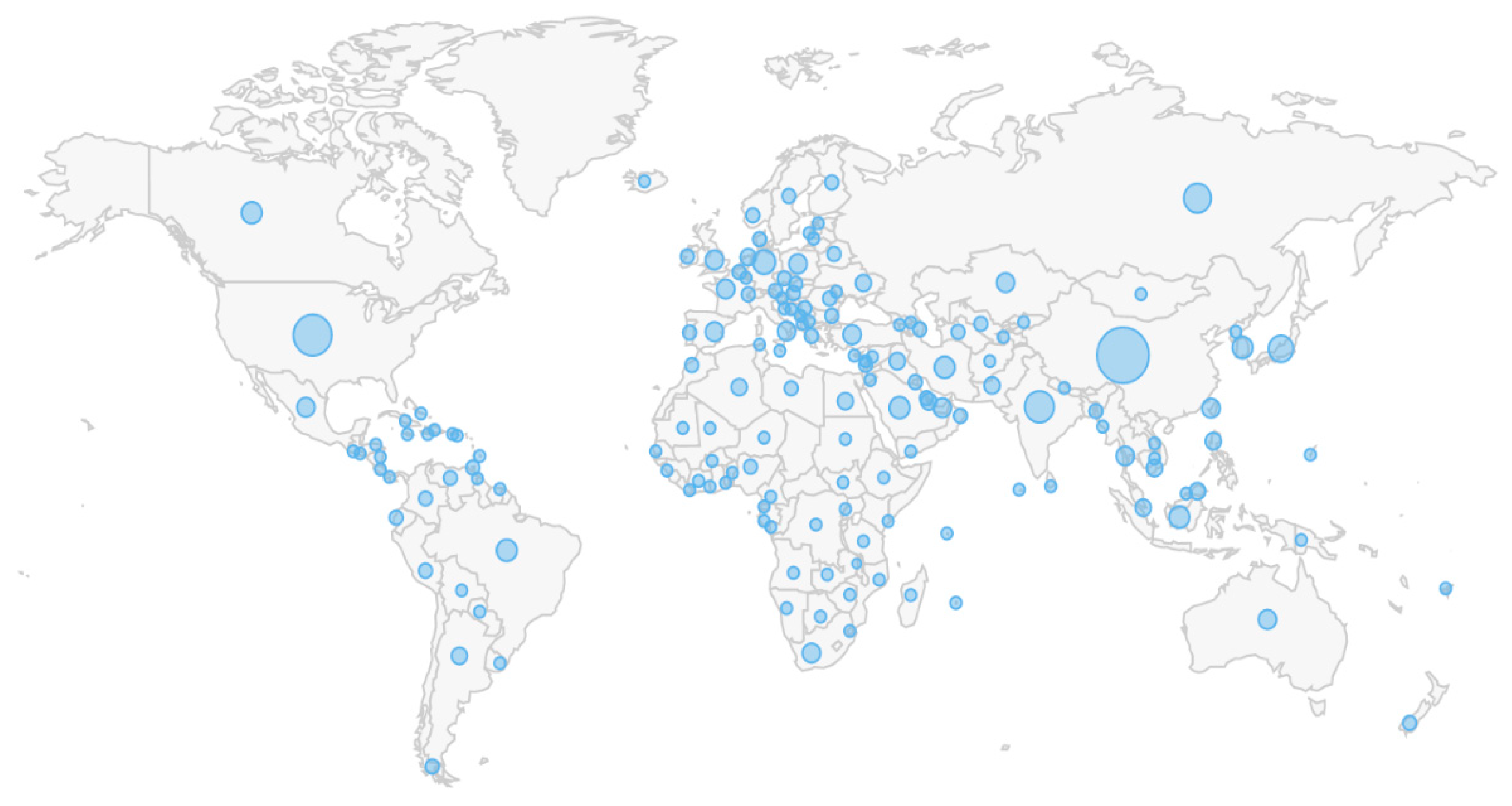
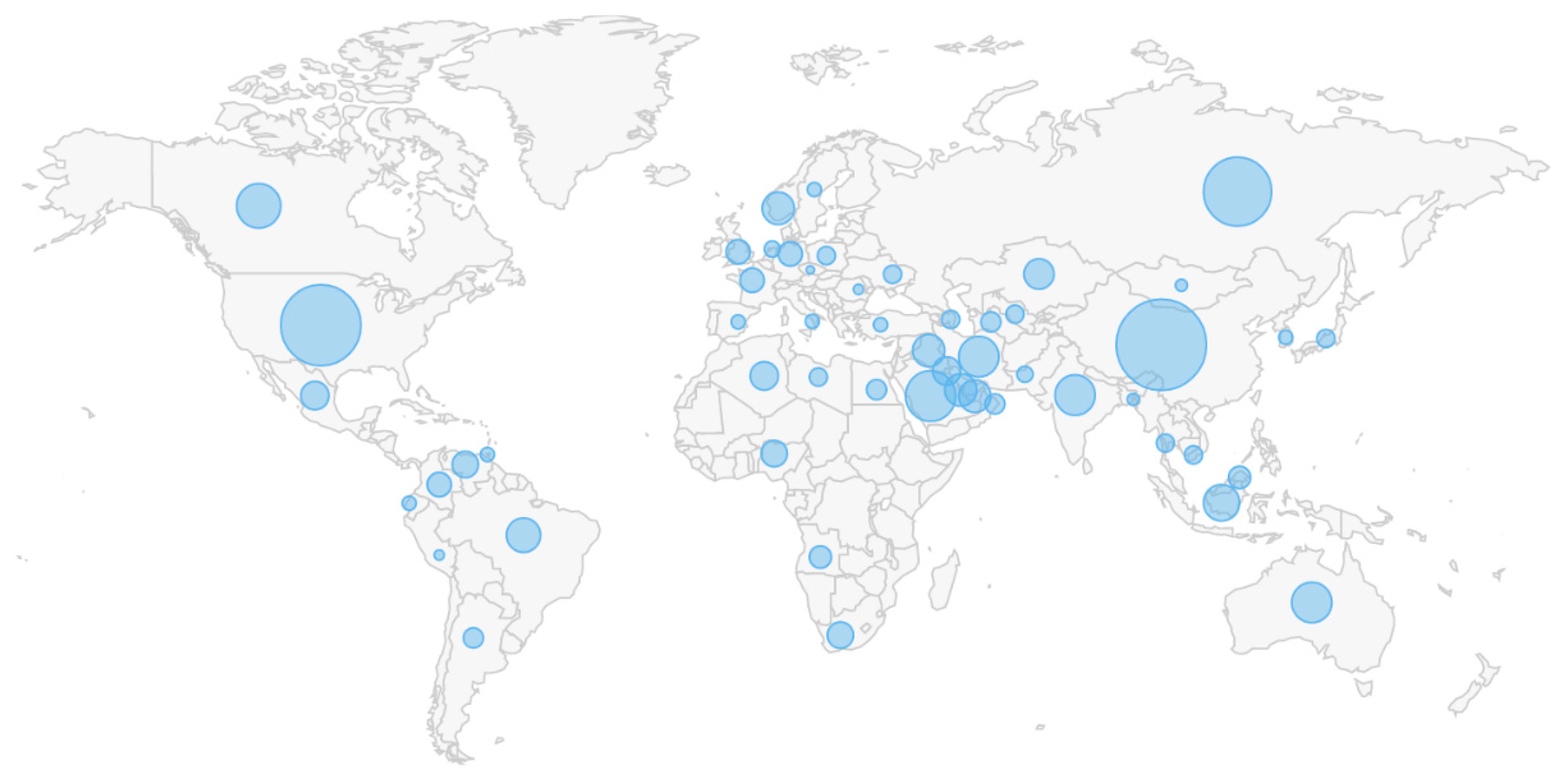
| Sectoral Scope | Actual/Expected Annual Investment (USD Trillion) [1] | Investment Need (USD Trillion) | ||
|---|---|---|---|---|
| Time Frame | Total | Per Annum | ||
| Including power generation, transmission and distribution, primary energy supply, energy demand and efficiency, transport, water and sanitation, and telecommunication | 3.4 (2015) | 2015–2030 | 75–86 | 5–6 |
| - | 2015–2030 | 96 | 6.4 | |
| 3.4–4.4 (2017) | 2016–2030 | 95 | 6.3 (or 6.9 under a 2 °C scenario) | |
| Including roads, railways, airports, electricity generation, transmission and distribution, water, and telecommunication | 2.3 (2015) growing to 3.8 (2040) | 2015–2040 | 94 | 2.9 (2015)–4.6 (2040) |
| Including transport (roads, railways, airports, and ports), water, power, and telecommunication | 2.5 | 2016–2030 | 49 | 3.3 |
| Interaction | Human Activities | Levels of Impact |
|---|---|---|
| Atmosphere–Biosphere |
| Local, regional, and global |
| Geosphere–Hydrosphere |
| Global |
| Atmosphere–Geosphere |
| Global and regional |
| Biosphere–Hydrosphere |
| Local, regional, and global |
| Atmosphere–Hydrosphere |
| Global |
| Geosphere–Biosphere |
| Global and regional |
| Narrative | Focus |
|---|---|
| Naturalist | Emphasizes what, how, and when humans have altered the earth system, with particular attention to the potential of interdisciplinary integration to provide scientific and technological knowledge to society and policy makers with respect to adaptation and mitigation of the impacts of global change. |
| Post-nature | It deploys the term Anthropocene as a symbol of post-modernity, where the dichotomy between culture and nature is dissolved, and where the concept of the Anthropocene is seen as a useful alternative, even if it conveys multiple and sometimes unclear meanings to go beyond the upheavals of modernity. |
| Eco-catastrophe | It focuses on the vulnerabilities of society and the dangers of unknown social and environmental tipping points, highlighting historical studies of civilizational collapses, narratives and interpretations of crises, limits to development, and the debate on population |
| Eco-Marxist | It focuses on the contradictions of capitalism in promoting growth, life quality, and technological advances, while causing environmental disasters. The emphasis is on the development of the social metabolism from a historical perspective and its role in unequal global social relations |
Publisher’s Note: MDPI stays neutral with regard to jurisdictional claims in published maps and institutional affiliations. |
© 2021 by the author. Licensee MDPI, Basel, Switzerland. This article is an open access article distributed under the terms and conditions of the Creative Commons Attribution (CC BY) license (https://creativecommons.org/licenses/by/4.0/).
Share and Cite
Lugo-Morin, D.R. Global Future: Low-Carbon Economy or High-Carbon Economy? World 2021, 2, 175-193. https://doi.org/10.3390/world2020012
Lugo-Morin DR. Global Future: Low-Carbon Economy or High-Carbon Economy? World. 2021; 2(2):175-193. https://doi.org/10.3390/world2020012
Chicago/Turabian StyleLugo-Morin, Diosey Ramon. 2021. "Global Future: Low-Carbon Economy or High-Carbon Economy?" World 2, no. 2: 175-193. https://doi.org/10.3390/world2020012
APA StyleLugo-Morin, D. R. (2021). Global Future: Low-Carbon Economy or High-Carbon Economy? World, 2(2), 175-193. https://doi.org/10.3390/world2020012






